Diploma in Hospitality: ACA Cafe' Restaurant Marketing Strategies Plan
VerifiedAdded on 2022/10/13
|13
|3309
|136
Report
AI Summary
This report presents a comprehensive business plan and marketing strategy analysis for ACA Cafe' Restaurant, covering various aspects of its operations. The report begins with an analysis of market research methods, including primary data collection techniques like face-to-face meetings and feedback collection, and discusses the importance of marketing planning techniques such as marketing mix strategies and contingency plans. It examines the evolution of the cafe's marketing strategies, from traditional methods to digital marketing, and includes a comparative analysis of benchmarking practices. The report delves into internal and external issues, using SWOT and PEST analyses to assess strengths, weaknesses, opportunities, and threats, as well as political, economic, social, and technological factors. Furthermore, it defines market objectives, positioning strategies, and a unique selling proposition, detailing the 7 P's of marketing mix to outline pricing, product, place, promotion, people, process, and physical evidence strategies. The report concludes with an examination of ethical and sustainability considerations and future target markets.
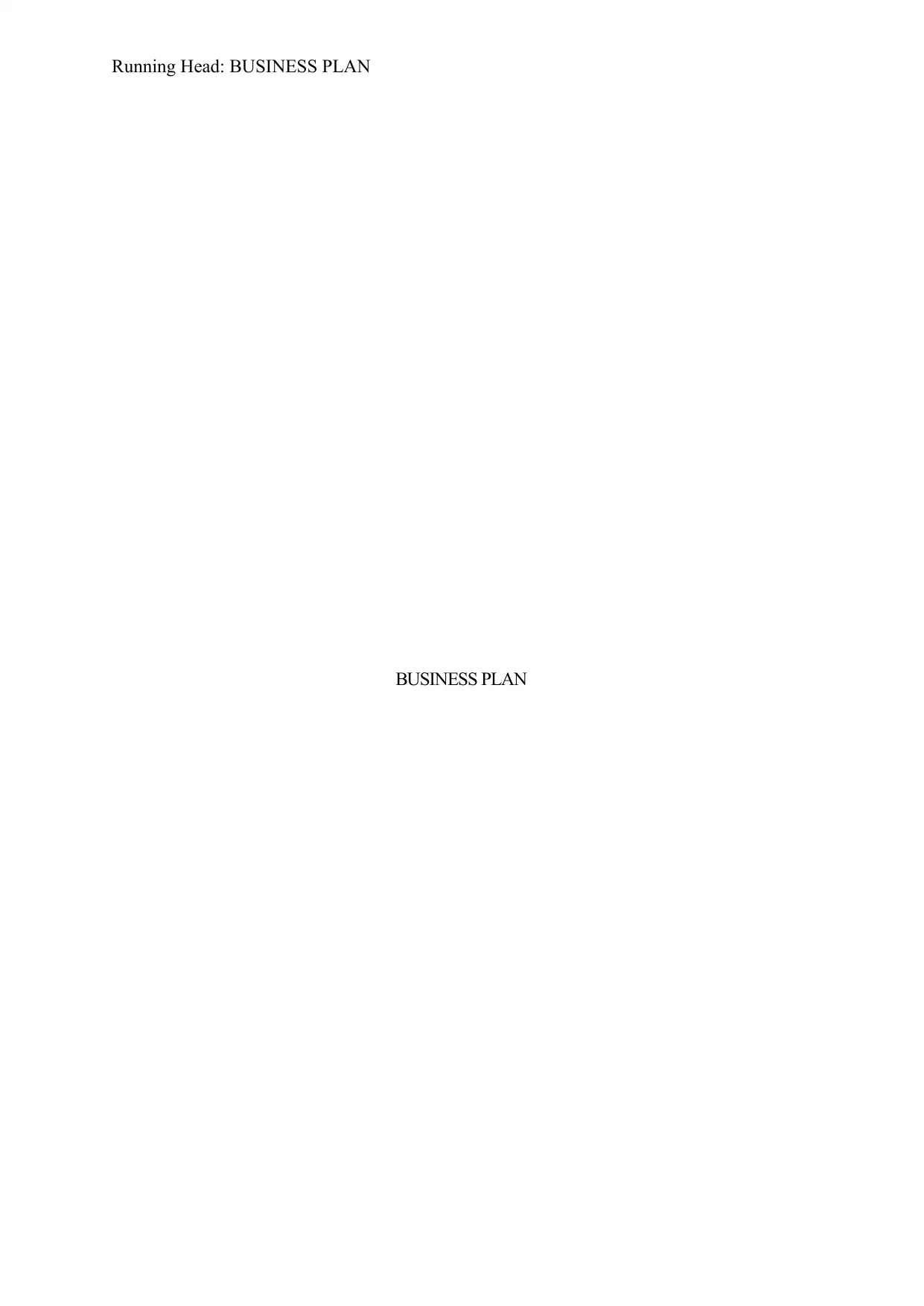
Running Head: BUSINESS PLAN
BUSINESS PLAN
BUSINESS PLAN
Paraphrase This Document
Need a fresh take? Get an instant paraphrase of this document with our AI Paraphraser
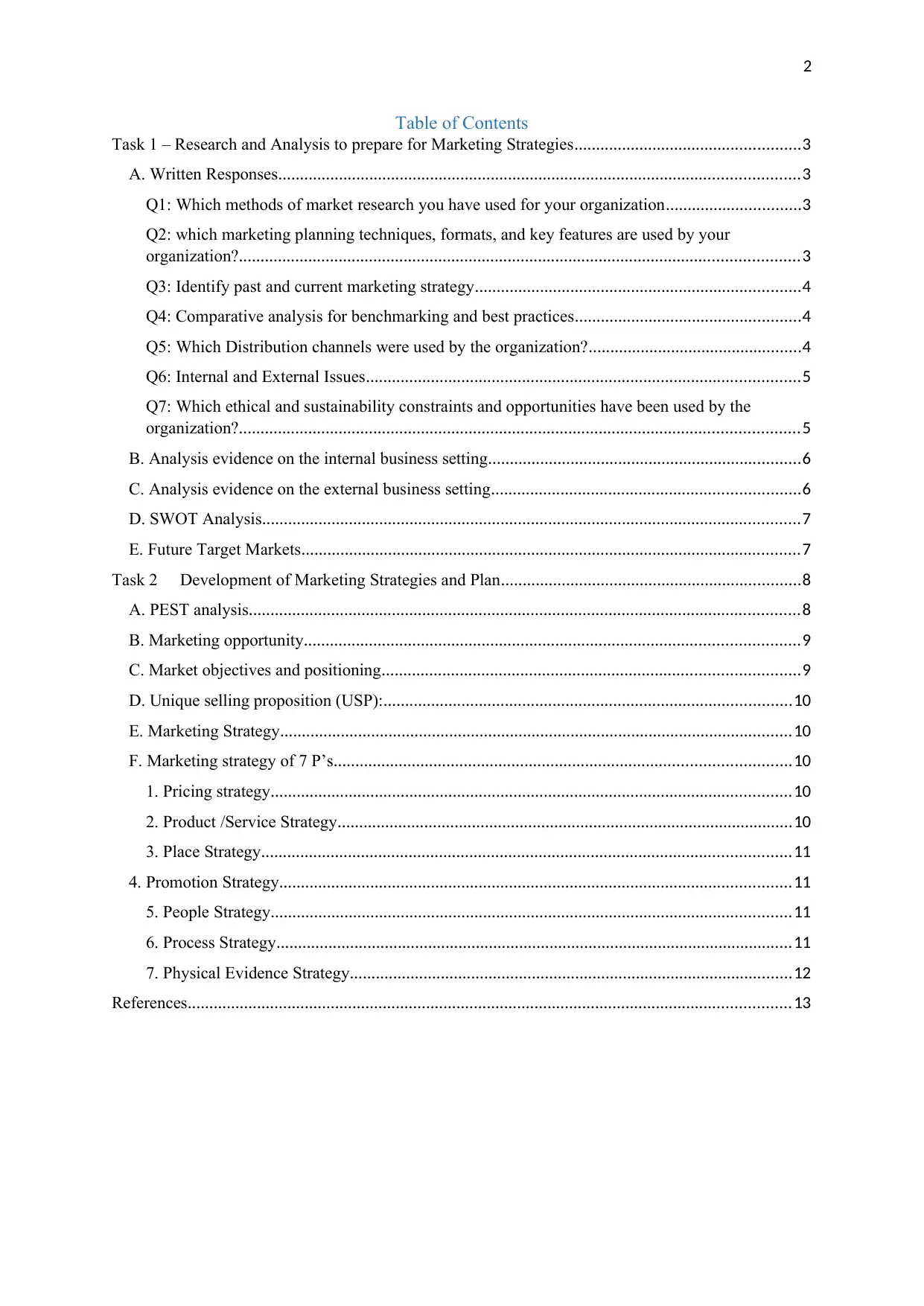
2
Table of Contents
Task 1 – Research and Analysis to prepare for Marketing Strategies....................................................3
A. Written Responses........................................................................................................................3
Q1: Which methods of market research you have used for your organization...............................3
Q2: which marketing planning techniques, formats, and key features are used by your
organization?.................................................................................................................................3
Q3: Identify past and current marketing strategy...........................................................................4
Q4: Comparative analysis for benchmarking and best practices....................................................4
Q5: Which Distribution channels were used by the organization?.................................................4
Q6: Internal and External Issues....................................................................................................5
Q7: Which ethical and sustainability constraints and opportunities have been used by the
organization?.................................................................................................................................5
B. Analysis evidence on the internal business setting........................................................................6
C. Analysis evidence on the external business setting.......................................................................6
D. SWOT Analysis............................................................................................................................7
E. Future Target Markets...................................................................................................................7
Task 2 Development of Marketing Strategies and Plan.....................................................................8
A. PEST analysis...............................................................................................................................8
B. Marketing opportunity..................................................................................................................9
C. Market objectives and positioning................................................................................................9
D. Unique selling proposition (USP):..............................................................................................10
E. Marketing Strategy......................................................................................................................10
F. Marketing strategy of 7 P’s.........................................................................................................10
1. Pricing strategy........................................................................................................................10
2. Product /Service Strategy.........................................................................................................10
3. Place Strategy..........................................................................................................................11
4. Promotion Strategy......................................................................................................................11
5. People Strategy........................................................................................................................11
6. Process Strategy.......................................................................................................................11
7. Physical Evidence Strategy......................................................................................................12
References...........................................................................................................................................13
Table of Contents
Task 1 – Research and Analysis to prepare for Marketing Strategies....................................................3
A. Written Responses........................................................................................................................3
Q1: Which methods of market research you have used for your organization...............................3
Q2: which marketing planning techniques, formats, and key features are used by your
organization?.................................................................................................................................3
Q3: Identify past and current marketing strategy...........................................................................4
Q4: Comparative analysis for benchmarking and best practices....................................................4
Q5: Which Distribution channels were used by the organization?.................................................4
Q6: Internal and External Issues....................................................................................................5
Q7: Which ethical and sustainability constraints and opportunities have been used by the
organization?.................................................................................................................................5
B. Analysis evidence on the internal business setting........................................................................6
C. Analysis evidence on the external business setting.......................................................................6
D. SWOT Analysis............................................................................................................................7
E. Future Target Markets...................................................................................................................7
Task 2 Development of Marketing Strategies and Plan.....................................................................8
A. PEST analysis...............................................................................................................................8
B. Marketing opportunity..................................................................................................................9
C. Market objectives and positioning................................................................................................9
D. Unique selling proposition (USP):..............................................................................................10
E. Marketing Strategy......................................................................................................................10
F. Marketing strategy of 7 P’s.........................................................................................................10
1. Pricing strategy........................................................................................................................10
2. Product /Service Strategy.........................................................................................................10
3. Place Strategy..........................................................................................................................11
4. Promotion Strategy......................................................................................................................11
5. People Strategy........................................................................................................................11
6. Process Strategy.......................................................................................................................11
7. Physical Evidence Strategy......................................................................................................12
References...........................................................................................................................................13
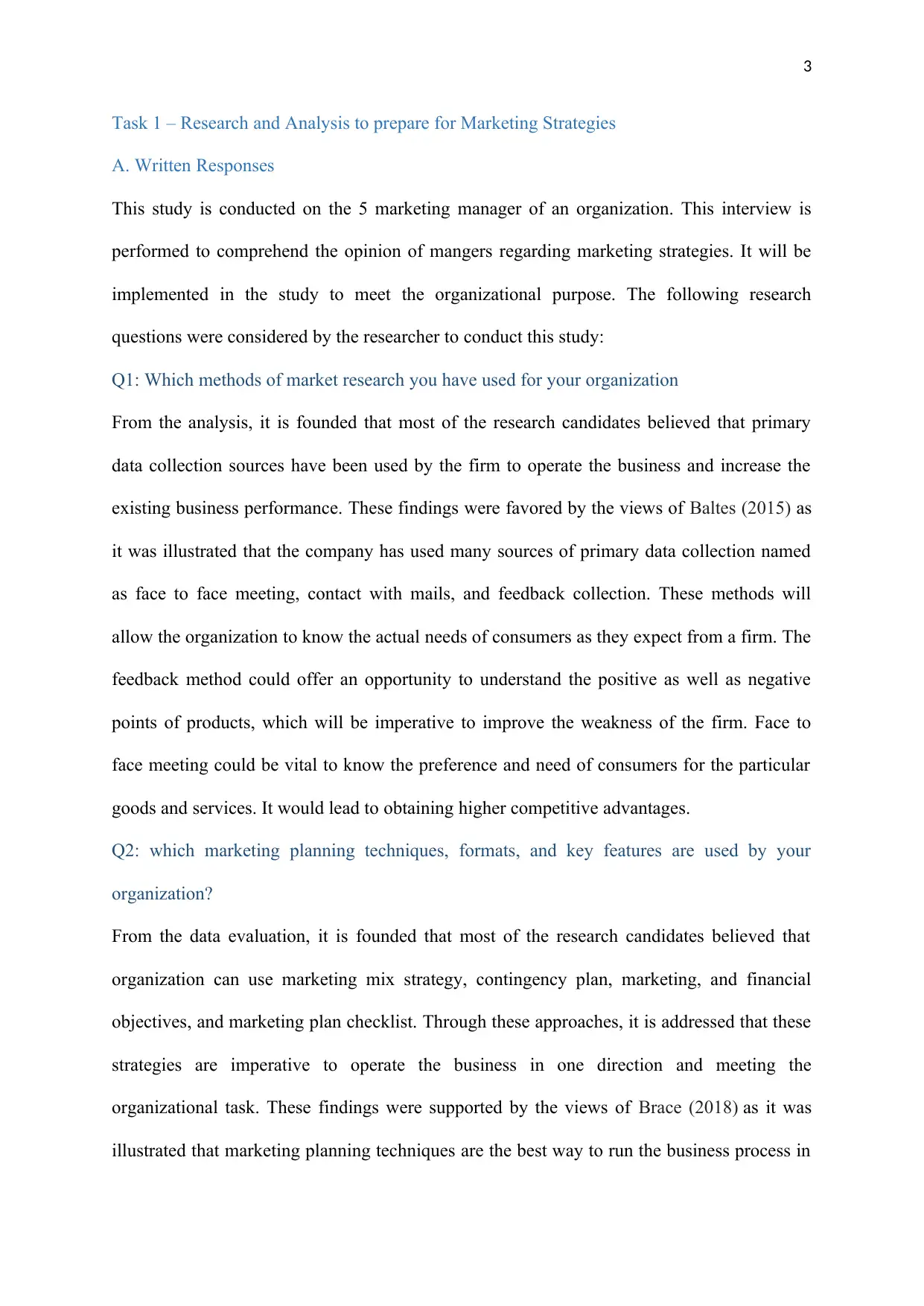
3
Task 1 – Research and Analysis to prepare for Marketing Strategies
A. Written Responses
This study is conducted on the 5 marketing manager of an organization. This interview is
performed to comprehend the opinion of mangers regarding marketing strategies. It will be
implemented in the study to meet the organizational purpose. The following research
questions were considered by the researcher to conduct this study:
Q1: Which methods of market research you have used for your organization
From the analysis, it is founded that most of the research candidates believed that primary
data collection sources have been used by the firm to operate the business and increase the
existing business performance. These findings were favored by the views of Baltes (2015) as
it was illustrated that the company has used many sources of primary data collection named
as face to face meeting, contact with mails, and feedback collection. These methods will
allow the organization to know the actual needs of consumers as they expect from a firm. The
feedback method could offer an opportunity to understand the positive as well as negative
points of products, which will be imperative to improve the weakness of the firm. Face to
face meeting could be vital to know the preference and need of consumers for the particular
goods and services. It would lead to obtaining higher competitive advantages.
Q2: which marketing planning techniques, formats, and key features are used by your
organization?
From the data evaluation, it is founded that most of the research candidates believed that
organization can use marketing mix strategy, contingency plan, marketing, and financial
objectives, and marketing plan checklist. Through these approaches, it is addressed that these
strategies are imperative to operate the business in one direction and meeting the
organizational task. These findings were supported by the views of Brace (2018) as it was
illustrated that marketing planning techniques are the best way to run the business process in
Task 1 – Research and Analysis to prepare for Marketing Strategies
A. Written Responses
This study is conducted on the 5 marketing manager of an organization. This interview is
performed to comprehend the opinion of mangers regarding marketing strategies. It will be
implemented in the study to meet the organizational purpose. The following research
questions were considered by the researcher to conduct this study:
Q1: Which methods of market research you have used for your organization
From the analysis, it is founded that most of the research candidates believed that primary
data collection sources have been used by the firm to operate the business and increase the
existing business performance. These findings were favored by the views of Baltes (2015) as
it was illustrated that the company has used many sources of primary data collection named
as face to face meeting, contact with mails, and feedback collection. These methods will
allow the organization to know the actual needs of consumers as they expect from a firm. The
feedback method could offer an opportunity to understand the positive as well as negative
points of products, which will be imperative to improve the weakness of the firm. Face to
face meeting could be vital to know the preference and need of consumers for the particular
goods and services. It would lead to obtaining higher competitive advantages.
Q2: which marketing planning techniques, formats, and key features are used by your
organization?
From the data evaluation, it is founded that most of the research candidates believed that
organization can use marketing mix strategy, contingency plan, marketing, and financial
objectives, and marketing plan checklist. Through these approaches, it is addressed that these
strategies are imperative to operate the business in one direction and meeting the
organizational task. These findings were supported by the views of Brace (2018) as it was
illustrated that marketing planning techniques are the best way to run the business process in
⊘ This is a preview!⊘
Do you want full access?
Subscribe today to unlock all pages.

Trusted by 1+ million students worldwide
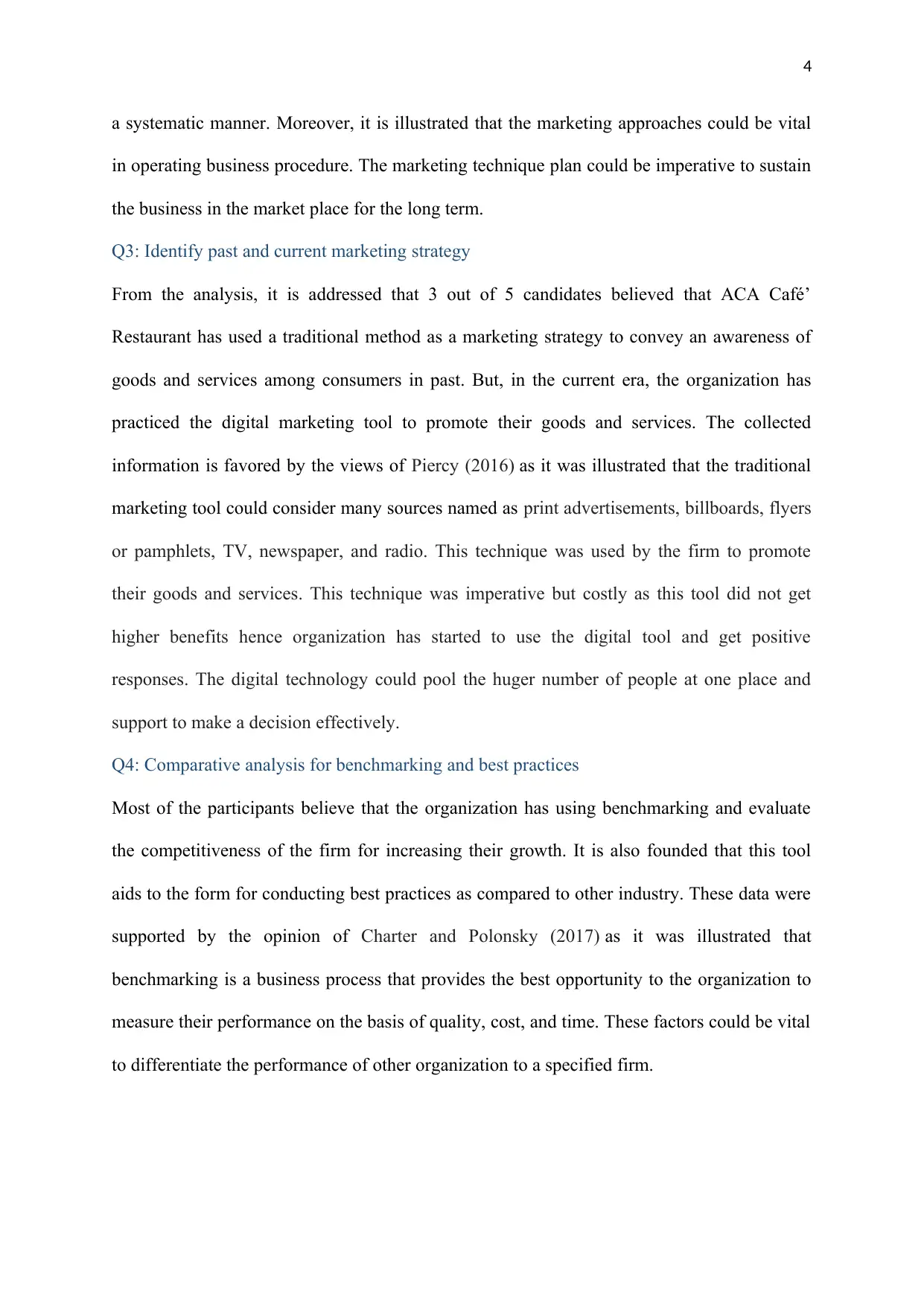
4
a systematic manner. Moreover, it is illustrated that the marketing approaches could be vital
in operating business procedure. The marketing technique plan could be imperative to sustain
the business in the market place for the long term.
Q3: Identify past and current marketing strategy
From the analysis, it is addressed that 3 out of 5 candidates believed that ACA Café’
Restaurant has used a traditional method as a marketing strategy to convey an awareness of
goods and services among consumers in past. But, in the current era, the organization has
practiced the digital marketing tool to promote their goods and services. The collected
information is favored by the views of Piercy (2016) as it was illustrated that the traditional
marketing tool could consider many sources named as print advertisements, billboards, flyers
or pamphlets, TV, newspaper, and radio. This technique was used by the firm to promote
their goods and services. This technique was imperative but costly as this tool did not get
higher benefits hence organization has started to use the digital tool and get positive
responses. The digital technology could pool the huger number of people at one place and
support to make a decision effectively.
Q4: Comparative analysis for benchmarking and best practices
Most of the participants believe that the organization has using benchmarking and evaluate
the competitiveness of the firm for increasing their growth. It is also founded that this tool
aids to the form for conducting best practices as compared to other industry. These data were
supported by the opinion of Charter and Polonsky (2017) as it was illustrated that
benchmarking is a business process that provides the best opportunity to the organization to
measure their performance on the basis of quality, cost, and time. These factors could be vital
to differentiate the performance of other organization to a specified firm.
a systematic manner. Moreover, it is illustrated that the marketing approaches could be vital
in operating business procedure. The marketing technique plan could be imperative to sustain
the business in the market place for the long term.
Q3: Identify past and current marketing strategy
From the analysis, it is addressed that 3 out of 5 candidates believed that ACA Café’
Restaurant has used a traditional method as a marketing strategy to convey an awareness of
goods and services among consumers in past. But, in the current era, the organization has
practiced the digital marketing tool to promote their goods and services. The collected
information is favored by the views of Piercy (2016) as it was illustrated that the traditional
marketing tool could consider many sources named as print advertisements, billboards, flyers
or pamphlets, TV, newspaper, and radio. This technique was used by the firm to promote
their goods and services. This technique was imperative but costly as this tool did not get
higher benefits hence organization has started to use the digital tool and get positive
responses. The digital technology could pool the huger number of people at one place and
support to make a decision effectively.
Q4: Comparative analysis for benchmarking and best practices
Most of the participants believe that the organization has using benchmarking and evaluate
the competitiveness of the firm for increasing their growth. It is also founded that this tool
aids to the form for conducting best practices as compared to other industry. These data were
supported by the opinion of Charter and Polonsky (2017) as it was illustrated that
benchmarking is a business process that provides the best opportunity to the organization to
measure their performance on the basis of quality, cost, and time. These factors could be vital
to differentiate the performance of other organization to a specified firm.
Paraphrase This Document
Need a fresh take? Get an instant paraphrase of this document with our AI Paraphraser
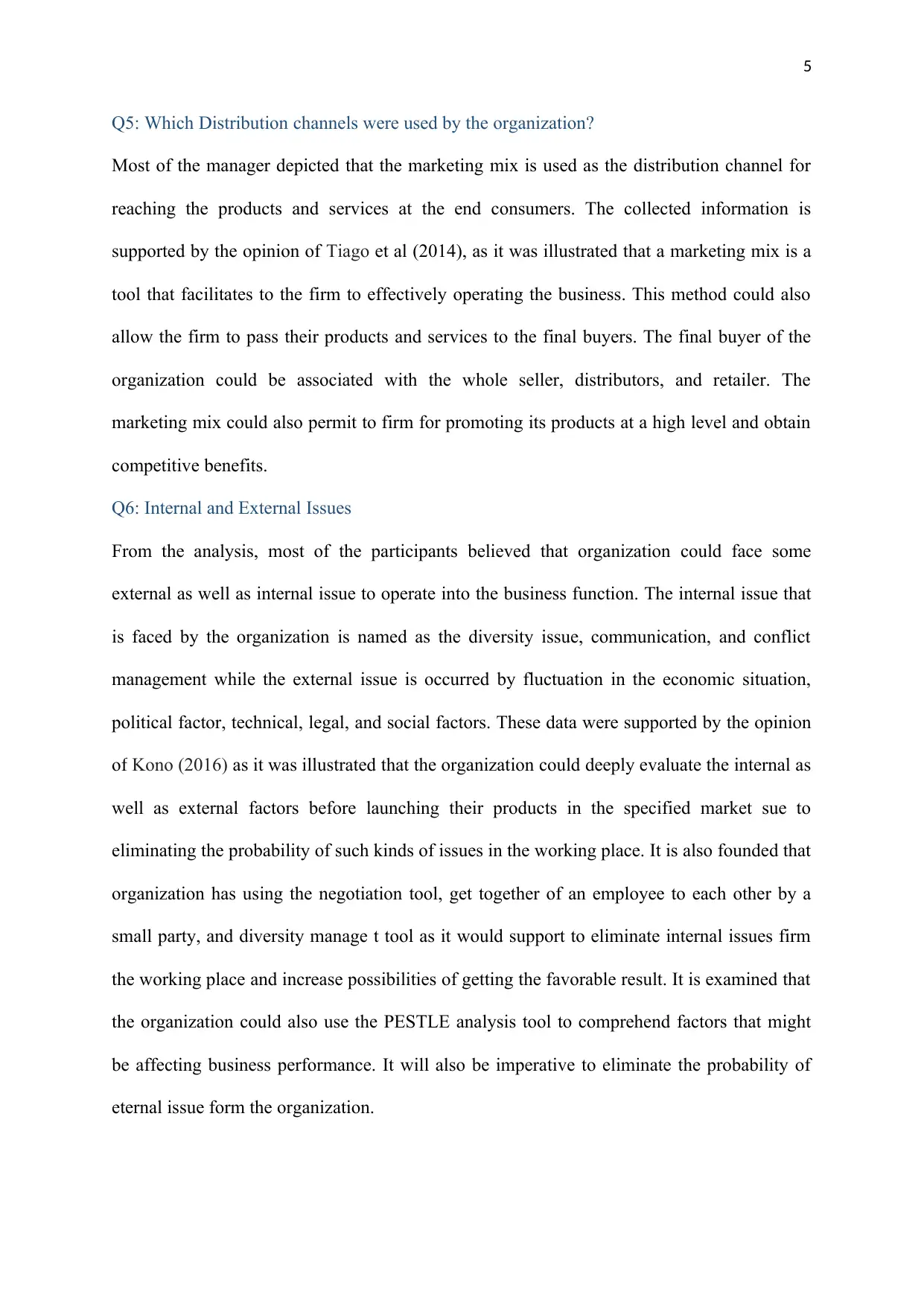
5
Q5: Which Distribution channels were used by the organization?
Most of the manager depicted that the marketing mix is used as the distribution channel for
reaching the products and services at the end consumers. The collected information is
supported by the opinion of Tiago et al (2014), as it was illustrated that a marketing mix is a
tool that facilitates to the firm to effectively operating the business. This method could also
allow the firm to pass their products and services to the final buyers. The final buyer of the
organization could be associated with the whole seller, distributors, and retailer. The
marketing mix could also permit to firm for promoting its products at a high level and obtain
competitive benefits.
Q6: Internal and External Issues
From the analysis, most of the participants believed that organization could face some
external as well as internal issue to operate into the business function. The internal issue that
is faced by the organization is named as the diversity issue, communication, and conflict
management while the external issue is occurred by fluctuation in the economic situation,
political factor, technical, legal, and social factors. These data were supported by the opinion
of Kono (2016) as it was illustrated that the organization could deeply evaluate the internal as
well as external factors before launching their products in the specified market sue to
eliminating the probability of such kinds of issues in the working place. It is also founded that
organization has using the negotiation tool, get together of an employee to each other by a
small party, and diversity manage t tool as it would support to eliminate internal issues firm
the working place and increase possibilities of getting the favorable result. It is examined that
the organization could also use the PESTLE analysis tool to comprehend factors that might
be affecting business performance. It will also be imperative to eliminate the probability of
eternal issue form the organization.
Q5: Which Distribution channels were used by the organization?
Most of the manager depicted that the marketing mix is used as the distribution channel for
reaching the products and services at the end consumers. The collected information is
supported by the opinion of Tiago et al (2014), as it was illustrated that a marketing mix is a
tool that facilitates to the firm to effectively operating the business. This method could also
allow the firm to pass their products and services to the final buyers. The final buyer of the
organization could be associated with the whole seller, distributors, and retailer. The
marketing mix could also permit to firm for promoting its products at a high level and obtain
competitive benefits.
Q6: Internal and External Issues
From the analysis, most of the participants believed that organization could face some
external as well as internal issue to operate into the business function. The internal issue that
is faced by the organization is named as the diversity issue, communication, and conflict
management while the external issue is occurred by fluctuation in the economic situation,
political factor, technical, legal, and social factors. These data were supported by the opinion
of Kono (2016) as it was illustrated that the organization could deeply evaluate the internal as
well as external factors before launching their products in the specified market sue to
eliminating the probability of such kinds of issues in the working place. It is also founded that
organization has using the negotiation tool, get together of an employee to each other by a
small party, and diversity manage t tool as it would support to eliminate internal issues firm
the working place and increase possibilities of getting the favorable result. It is examined that
the organization could also use the PESTLE analysis tool to comprehend factors that might
be affecting business performance. It will also be imperative to eliminate the probability of
eternal issue form the organization.
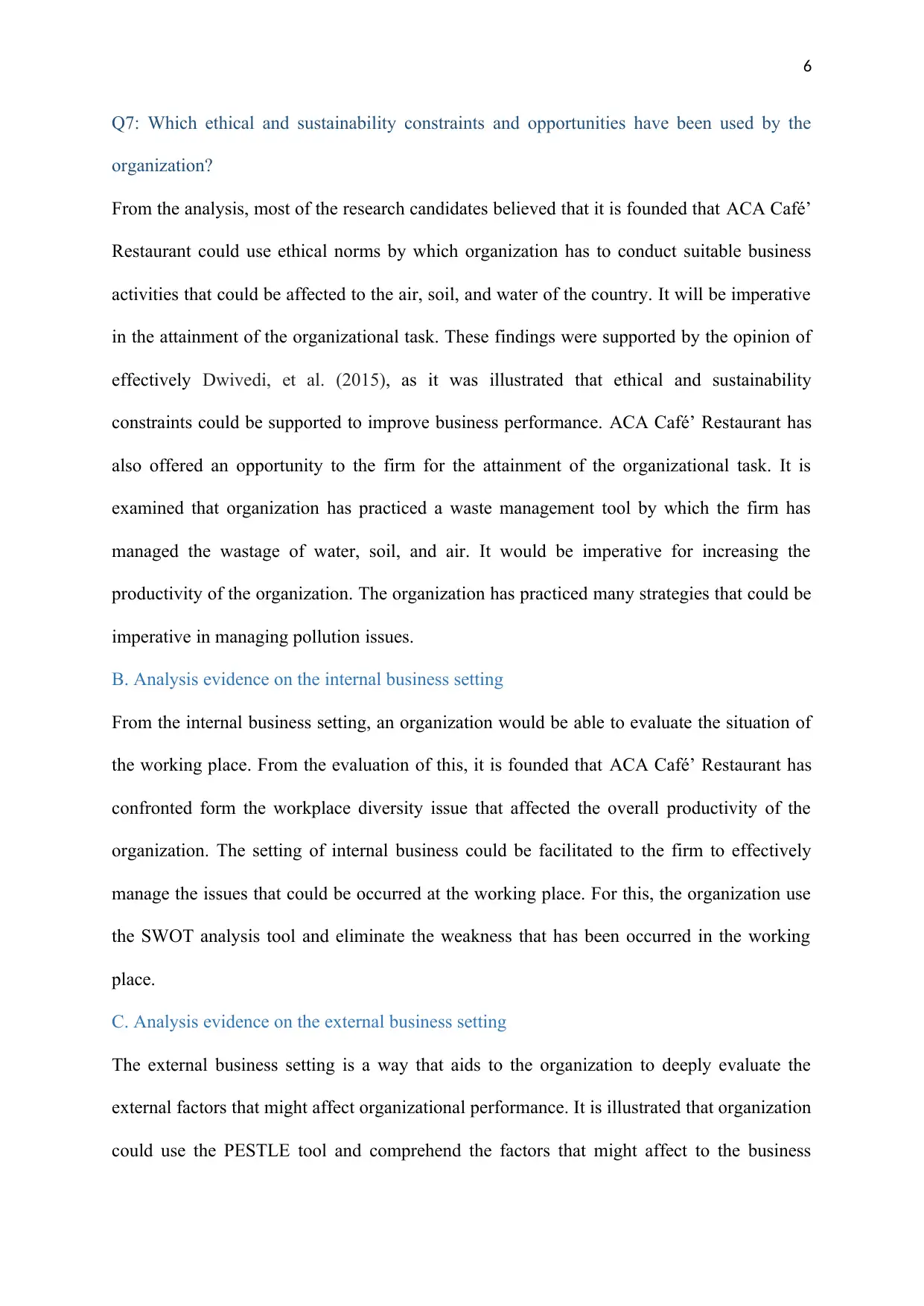
6
Q7: Which ethical and sustainability constraints and opportunities have been used by the
organization?
From the analysis, most of the research candidates believed that it is founded that ACA Café’
Restaurant could use ethical norms by which organization has to conduct suitable business
activities that could be affected to the air, soil, and water of the country. It will be imperative
in the attainment of the organizational task. These findings were supported by the opinion of
effectively Dwivedi, et al. (2015), as it was illustrated that ethical and sustainability
constraints could be supported to improve business performance. ACA Café’ Restaurant has
also offered an opportunity to the firm for the attainment of the organizational task. It is
examined that organization has practiced a waste management tool by which the firm has
managed the wastage of water, soil, and air. It would be imperative for increasing the
productivity of the organization. The organization has practiced many strategies that could be
imperative in managing pollution issues.
B. Analysis evidence on the internal business setting
From the internal business setting, an organization would be able to evaluate the situation of
the working place. From the evaluation of this, it is founded that ACA Café’ Restaurant has
confronted form the workplace diversity issue that affected the overall productivity of the
organization. The setting of internal business could be facilitated to the firm to effectively
manage the issues that could be occurred at the working place. For this, the organization use
the SWOT analysis tool and eliminate the weakness that has been occurred in the working
place.
C. Analysis evidence on the external business setting
The external business setting is a way that aids to the organization to deeply evaluate the
external factors that might affect organizational performance. It is illustrated that organization
could use the PESTLE tool and comprehend the factors that might affect to the business
Q7: Which ethical and sustainability constraints and opportunities have been used by the
organization?
From the analysis, most of the research candidates believed that it is founded that ACA Café’
Restaurant could use ethical norms by which organization has to conduct suitable business
activities that could be affected to the air, soil, and water of the country. It will be imperative
in the attainment of the organizational task. These findings were supported by the opinion of
effectively Dwivedi, et al. (2015), as it was illustrated that ethical and sustainability
constraints could be supported to improve business performance. ACA Café’ Restaurant has
also offered an opportunity to the firm for the attainment of the organizational task. It is
examined that organization has practiced a waste management tool by which the firm has
managed the wastage of water, soil, and air. It would be imperative for increasing the
productivity of the organization. The organization has practiced many strategies that could be
imperative in managing pollution issues.
B. Analysis evidence on the internal business setting
From the internal business setting, an organization would be able to evaluate the situation of
the working place. From the evaluation of this, it is founded that ACA Café’ Restaurant has
confronted form the workplace diversity issue that affected the overall productivity of the
organization. The setting of internal business could be facilitated to the firm to effectively
manage the issues that could be occurred at the working place. For this, the organization use
the SWOT analysis tool and eliminate the weakness that has been occurred in the working
place.
C. Analysis evidence on the external business setting
The external business setting is a way that aids to the organization to deeply evaluate the
external factors that might affect organizational performance. It is illustrated that organization
could use the PESTLE tool and comprehend the factors that might affect to the business
⊘ This is a preview!⊘
Do you want full access?
Subscribe today to unlock all pages.

Trusted by 1+ million students worldwide
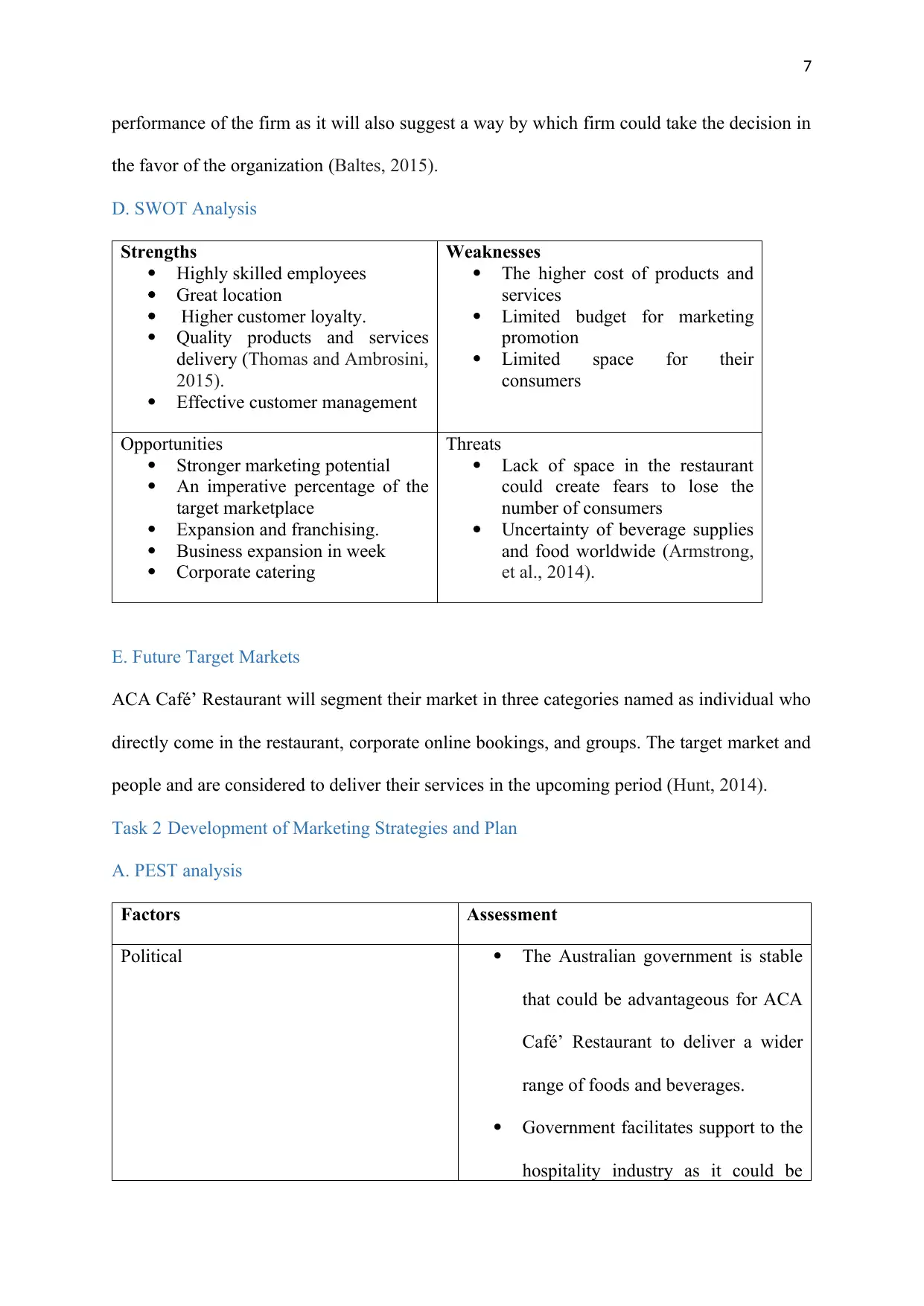
7
performance of the firm as it will also suggest a way by which firm could take the decision in
the favor of the organization (Baltes, 2015).
D. SWOT Analysis
Strengths
Highly skilled employees
Great location
Higher customer loyalty.
Quality products and services
delivery (Thomas and Ambrosini,
2015).
Effective customer management
Weaknesses
The higher cost of products and
services
Limited budget for marketing
promotion
Limited space for their
consumers
Opportunities
Stronger marketing potential
An imperative percentage of the
target marketplace
Expansion and franchising.
Business expansion in week
Corporate catering
Threats
Lack of space in the restaurant
could create fears to lose the
number of consumers
Uncertainty of beverage supplies
and food worldwide (Armstrong,
et al., 2014).
E. Future Target Markets
ACA Café’ Restaurant will segment their market in three categories named as individual who
directly come in the restaurant, corporate online bookings, and groups. The target market and
people and are considered to deliver their services in the upcoming period (Hunt, 2014).
Task 2 Development of Marketing Strategies and Plan
A. PEST analysis
Factors Assessment
Political The Australian government is stable
that could be advantageous for ACA
Café’ Restaurant to deliver a wider
range of foods and beverages.
Government facilitates support to the
hospitality industry as it could be
performance of the firm as it will also suggest a way by which firm could take the decision in
the favor of the organization (Baltes, 2015).
D. SWOT Analysis
Strengths
Highly skilled employees
Great location
Higher customer loyalty.
Quality products and services
delivery (Thomas and Ambrosini,
2015).
Effective customer management
Weaknesses
The higher cost of products and
services
Limited budget for marketing
promotion
Limited space for their
consumers
Opportunities
Stronger marketing potential
An imperative percentage of the
target marketplace
Expansion and franchising.
Business expansion in week
Corporate catering
Threats
Lack of space in the restaurant
could create fears to lose the
number of consumers
Uncertainty of beverage supplies
and food worldwide (Armstrong,
et al., 2014).
E. Future Target Markets
ACA Café’ Restaurant will segment their market in three categories named as individual who
directly come in the restaurant, corporate online bookings, and groups. The target market and
people and are considered to deliver their services in the upcoming period (Hunt, 2014).
Task 2 Development of Marketing Strategies and Plan
A. PEST analysis
Factors Assessment
Political The Australian government is stable
that could be advantageous for ACA
Café’ Restaurant to deliver a wider
range of foods and beverages.
Government facilitates support to the
hospitality industry as it could be
Paraphrase This Document
Need a fresh take? Get an instant paraphrase of this document with our AI Paraphraser
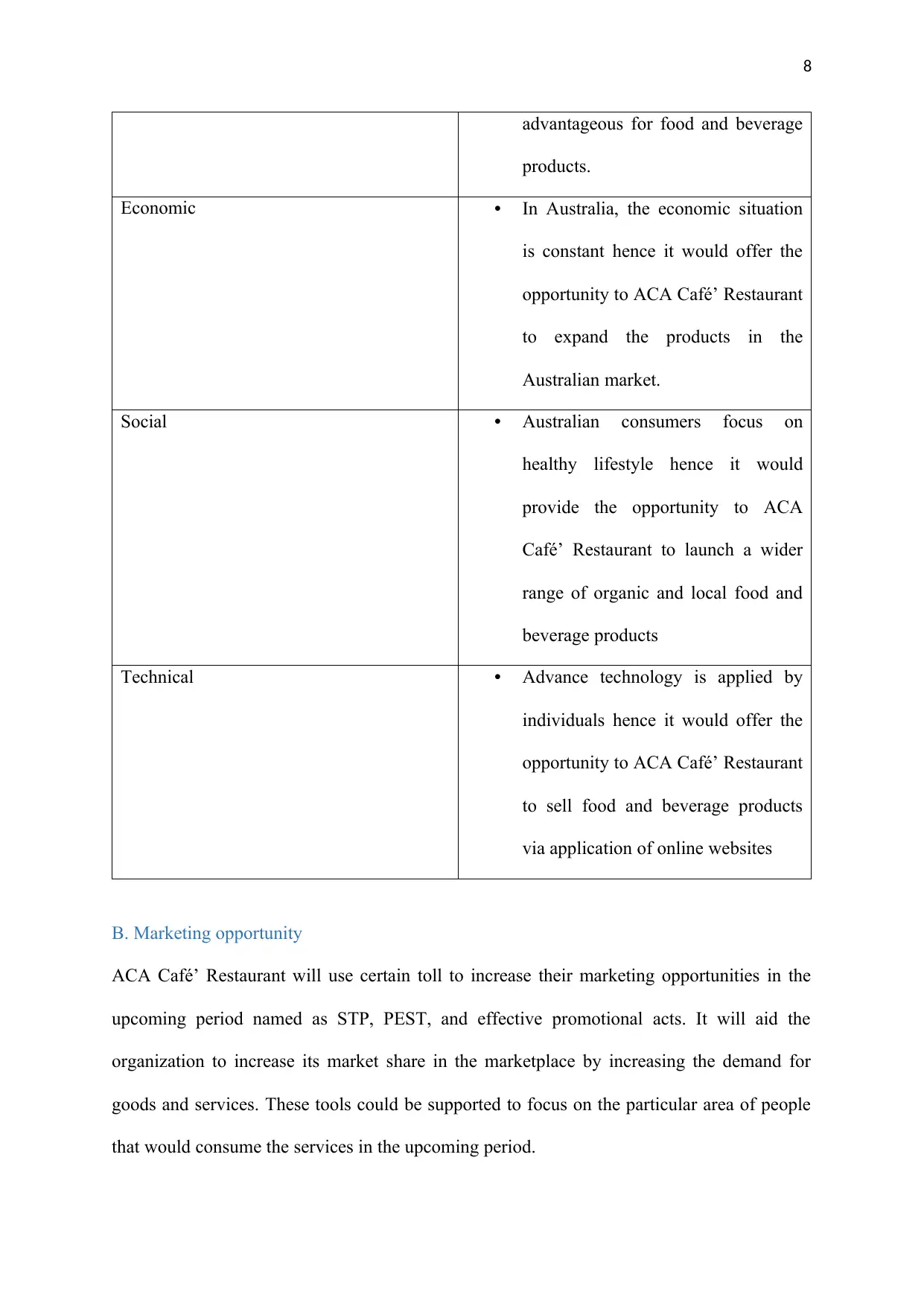
8
advantageous for food and beverage
products.
Economic • In Australia, the economic situation
is constant hence it would offer the
opportunity to ACA Café’ Restaurant
to expand the products in the
Australian market.
Social • Australian consumers focus on
healthy lifestyle hence it would
provide the opportunity to ACA
Café’ Restaurant to launch a wider
range of organic and local food and
beverage products
Technical • Advance technology is applied by
individuals hence it would offer the
opportunity to ACA Café’ Restaurant
to sell food and beverage products
via application of online websites
B. Marketing opportunity
ACA Café’ Restaurant will use certain toll to increase their marketing opportunities in the
upcoming period named as STP, PEST, and effective promotional acts. It will aid the
organization to increase its market share in the marketplace by increasing the demand for
goods and services. These tools could be supported to focus on the particular area of people
that would consume the services in the upcoming period.
advantageous for food and beverage
products.
Economic • In Australia, the economic situation
is constant hence it would offer the
opportunity to ACA Café’ Restaurant
to expand the products in the
Australian market.
Social • Australian consumers focus on
healthy lifestyle hence it would
provide the opportunity to ACA
Café’ Restaurant to launch a wider
range of organic and local food and
beverage products
Technical • Advance technology is applied by
individuals hence it would offer the
opportunity to ACA Café’ Restaurant
to sell food and beverage products
via application of online websites
B. Marketing opportunity
ACA Café’ Restaurant will use certain toll to increase their marketing opportunities in the
upcoming period named as STP, PEST, and effective promotional acts. It will aid the
organization to increase its market share in the marketplace by increasing the demand for
goods and services. These tools could be supported to focus on the particular area of people
that would consume the services in the upcoming period.
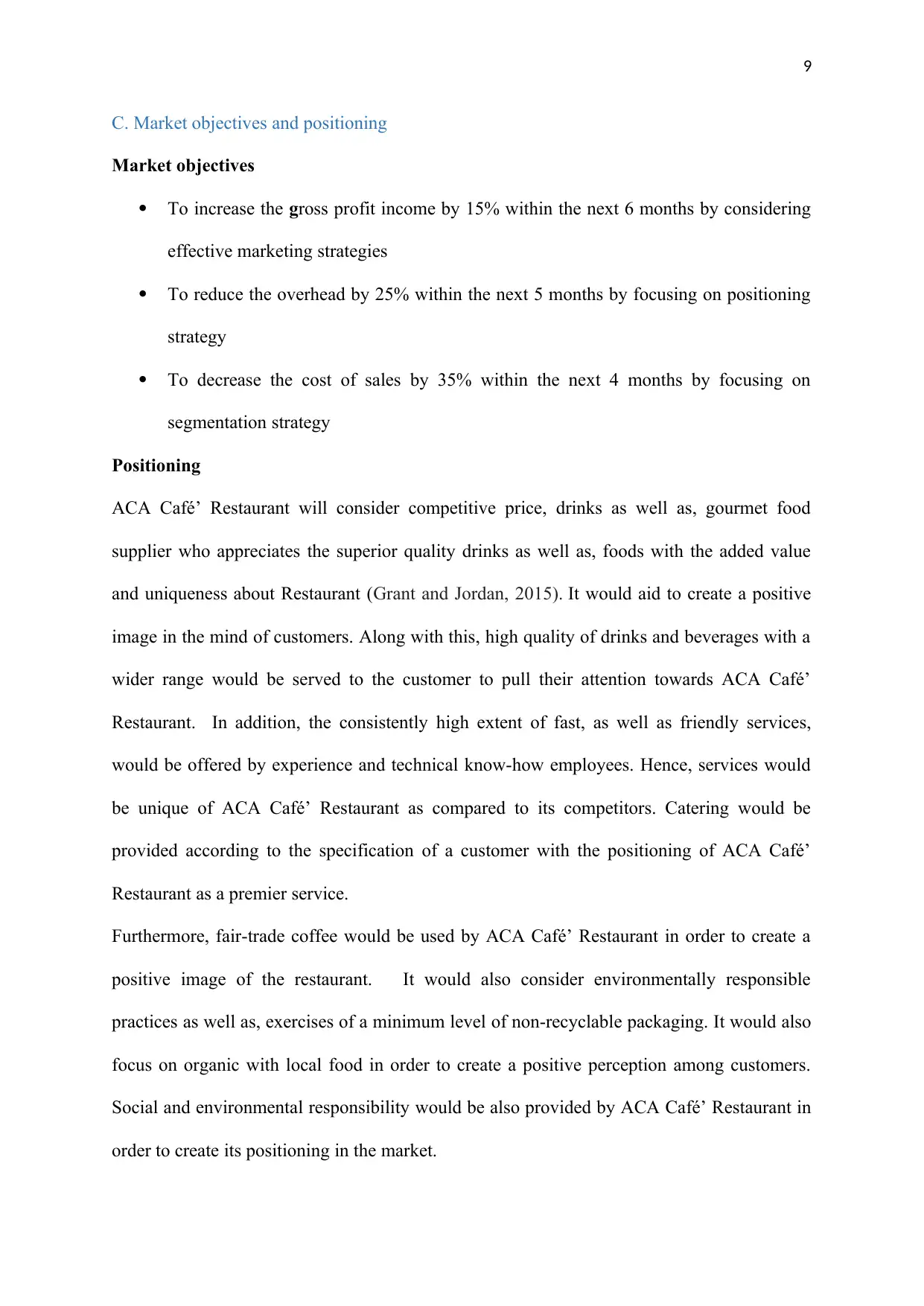
9
C. Market objectives and positioning
Market objectives
To increase the gross profit income by 15% within the next 6 months by considering
effective marketing strategies
To reduce the overhead by 25% within the next 5 months by focusing on positioning
strategy
To decrease the cost of sales by 35% within the next 4 months by focusing on
segmentation strategy
Positioning
ACA Café’ Restaurant will consider competitive price, drinks as well as, gourmet food
supplier who appreciates the superior quality drinks as well as, foods with the added value
and uniqueness about Restaurant (Grant and Jordan, 2015). It would aid to create a positive
image in the mind of customers. Along with this, high quality of drinks and beverages with a
wider range would be served to the customer to pull their attention towards ACA Café’
Restaurant. In addition, the consistently high extent of fast, as well as friendly services,
would be offered by experience and technical know-how employees. Hence, services would
be unique of ACA Café’ Restaurant as compared to its competitors. Catering would be
provided according to the specification of a customer with the positioning of ACA Café’
Restaurant as a premier service.
Furthermore, fair-trade coffee would be used by ACA Café’ Restaurant in order to create a
positive image of the restaurant. It would also consider environmentally responsible
practices as well as, exercises of a minimum level of non-recyclable packaging. It would also
focus on organic with local food in order to create a positive perception among customers.
Social and environmental responsibility would be also provided by ACA Café’ Restaurant in
order to create its positioning in the market.
C. Market objectives and positioning
Market objectives
To increase the gross profit income by 15% within the next 6 months by considering
effective marketing strategies
To reduce the overhead by 25% within the next 5 months by focusing on positioning
strategy
To decrease the cost of sales by 35% within the next 4 months by focusing on
segmentation strategy
Positioning
ACA Café’ Restaurant will consider competitive price, drinks as well as, gourmet food
supplier who appreciates the superior quality drinks as well as, foods with the added value
and uniqueness about Restaurant (Grant and Jordan, 2015). It would aid to create a positive
image in the mind of customers. Along with this, high quality of drinks and beverages with a
wider range would be served to the customer to pull their attention towards ACA Café’
Restaurant. In addition, the consistently high extent of fast, as well as friendly services,
would be offered by experience and technical know-how employees. Hence, services would
be unique of ACA Café’ Restaurant as compared to its competitors. Catering would be
provided according to the specification of a customer with the positioning of ACA Café’
Restaurant as a premier service.
Furthermore, fair-trade coffee would be used by ACA Café’ Restaurant in order to create a
positive image of the restaurant. It would also consider environmentally responsible
practices as well as, exercises of a minimum level of non-recyclable packaging. It would also
focus on organic with local food in order to create a positive perception among customers.
Social and environmental responsibility would be also provided by ACA Café’ Restaurant in
order to create its positioning in the market.
⊘ This is a preview!⊘
Do you want full access?
Subscribe today to unlock all pages.

Trusted by 1+ million students worldwide
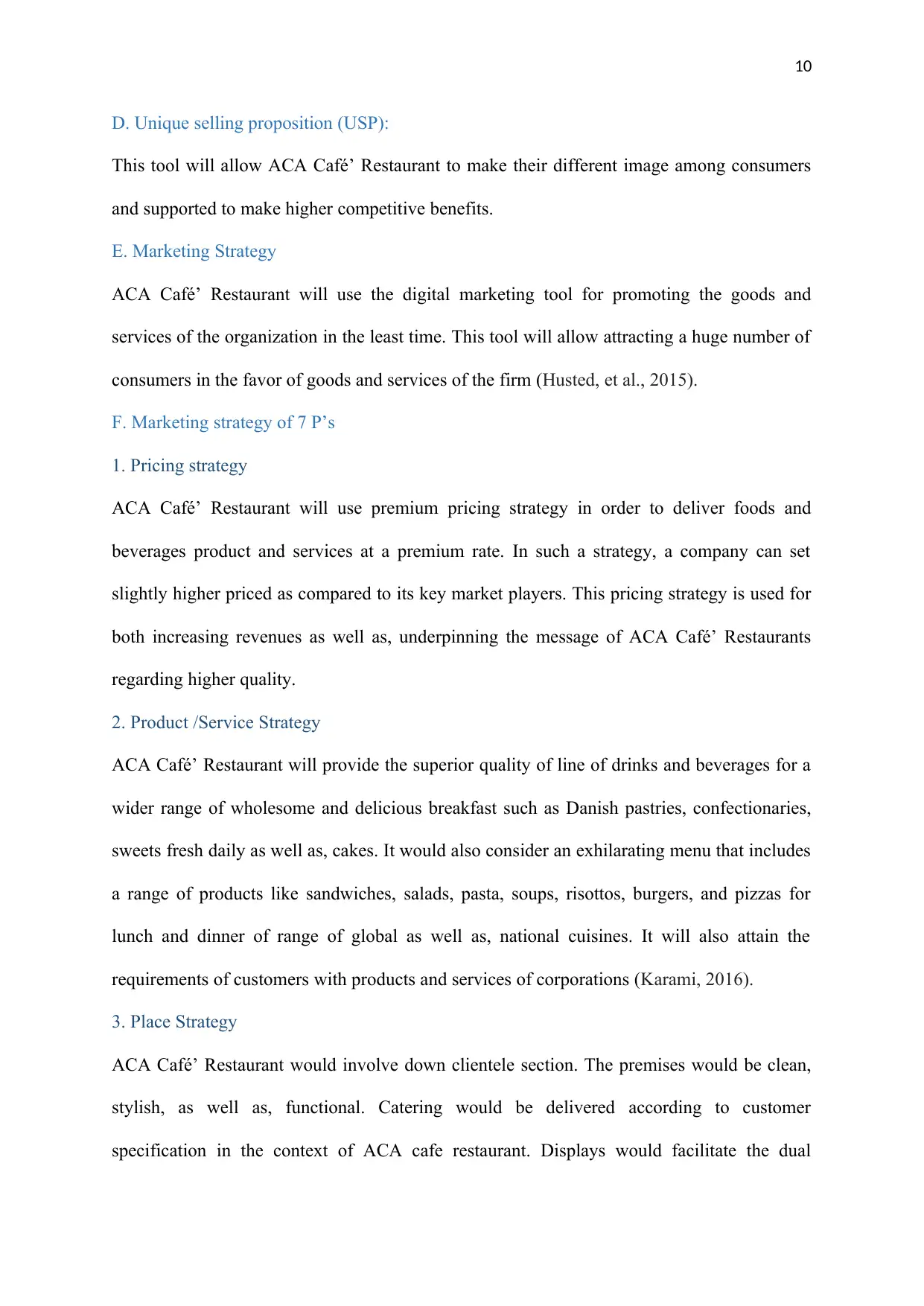
10
D. Unique selling proposition (USP):
This tool will allow ACA Café’ Restaurant to make their different image among consumers
and supported to make higher competitive benefits.
E. Marketing Strategy
ACA Café’ Restaurant will use the digital marketing tool for promoting the goods and
services of the organization in the least time. This tool will allow attracting a huge number of
consumers in the favor of goods and services of the firm (Husted, et al., 2015).
F. Marketing strategy of 7 P’s
1. Pricing strategy
ACA Café’ Restaurant will use premium pricing strategy in order to deliver foods and
beverages product and services at a premium rate. In such a strategy, a company can set
slightly higher priced as compared to its key market players. This pricing strategy is used for
both increasing revenues as well as, underpinning the message of ACA Café’ Restaurants
regarding higher quality.
2. Product /Service Strategy
ACA Café’ Restaurant will provide the superior quality of line of drinks and beverages for a
wider range of wholesome and delicious breakfast such as Danish pastries, confectionaries,
sweets fresh daily as well as, cakes. It would also consider an exhilarating menu that includes
a range of products like sandwiches, salads, pasta, soups, risottos, burgers, and pizzas for
lunch and dinner of range of global as well as, national cuisines. It will also attain the
requirements of customers with products and services of corporations (Karami, 2016).
3. Place Strategy
ACA Café’ Restaurant would involve down clientele section. The premises would be clean,
stylish, as well as, functional. Catering would be delivered according to customer
specification in the context of ACA cafe restaurant. Displays would facilitate the dual
D. Unique selling proposition (USP):
This tool will allow ACA Café’ Restaurant to make their different image among consumers
and supported to make higher competitive benefits.
E. Marketing Strategy
ACA Café’ Restaurant will use the digital marketing tool for promoting the goods and
services of the organization in the least time. This tool will allow attracting a huge number of
consumers in the favor of goods and services of the firm (Husted, et al., 2015).
F. Marketing strategy of 7 P’s
1. Pricing strategy
ACA Café’ Restaurant will use premium pricing strategy in order to deliver foods and
beverages product and services at a premium rate. In such a strategy, a company can set
slightly higher priced as compared to its key market players. This pricing strategy is used for
both increasing revenues as well as, underpinning the message of ACA Café’ Restaurants
regarding higher quality.
2. Product /Service Strategy
ACA Café’ Restaurant will provide the superior quality of line of drinks and beverages for a
wider range of wholesome and delicious breakfast such as Danish pastries, confectionaries,
sweets fresh daily as well as, cakes. It would also consider an exhilarating menu that includes
a range of products like sandwiches, salads, pasta, soups, risottos, burgers, and pizzas for
lunch and dinner of range of global as well as, national cuisines. It will also attain the
requirements of customers with products and services of corporations (Karami, 2016).
3. Place Strategy
ACA Café’ Restaurant would involve down clientele section. The premises would be clean,
stylish, as well as, functional. Catering would be delivered according to customer
specification in the context of ACA cafe restaurant. Displays would facilitate the dual
Paraphrase This Document
Need a fresh take? Get an instant paraphrase of this document with our AI Paraphraser
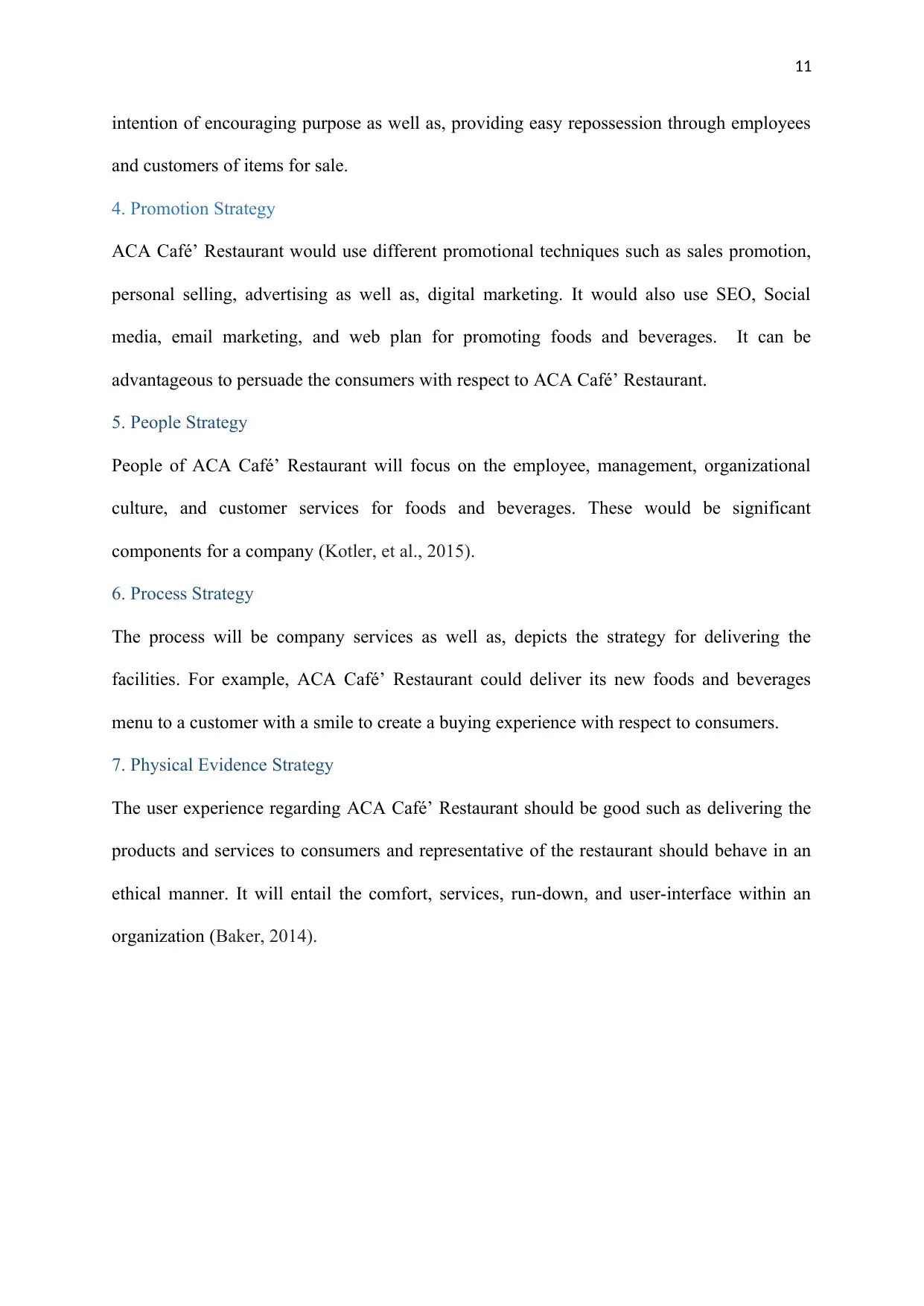
11
intention of encouraging purpose as well as, providing easy repossession through employees
and customers of items for sale.
4. Promotion Strategy
ACA Café’ Restaurant would use different promotional techniques such as sales promotion,
personal selling, advertising as well as, digital marketing. It would also use SEO, Social
media, email marketing, and web plan for promoting foods and beverages. It can be
advantageous to persuade the consumers with respect to ACA Café’ Restaurant.
5. People Strategy
People of ACA Café’ Restaurant will focus on the employee, management, organizational
culture, and customer services for foods and beverages. These would be significant
components for a company (Kotler, et al., 2015).
6. Process Strategy
The process will be company services as well as, depicts the strategy for delivering the
facilities. For example, ACA Café’ Restaurant could deliver its new foods and beverages
menu to a customer with a smile to create a buying experience with respect to consumers.
7. Physical Evidence Strategy
The user experience regarding ACA Café’ Restaurant should be good such as delivering the
products and services to consumers and representative of the restaurant should behave in an
ethical manner. It will entail the comfort, services, run-down, and user-interface within an
organization (Baker, 2014).
intention of encouraging purpose as well as, providing easy repossession through employees
and customers of items for sale.
4. Promotion Strategy
ACA Café’ Restaurant would use different promotional techniques such as sales promotion,
personal selling, advertising as well as, digital marketing. It would also use SEO, Social
media, email marketing, and web plan for promoting foods and beverages. It can be
advantageous to persuade the consumers with respect to ACA Café’ Restaurant.
5. People Strategy
People of ACA Café’ Restaurant will focus on the employee, management, organizational
culture, and customer services for foods and beverages. These would be significant
components for a company (Kotler, et al., 2015).
6. Process Strategy
The process will be company services as well as, depicts the strategy for delivering the
facilities. For example, ACA Café’ Restaurant could deliver its new foods and beverages
menu to a customer with a smile to create a buying experience with respect to consumers.
7. Physical Evidence Strategy
The user experience regarding ACA Café’ Restaurant should be good such as delivering the
products and services to consumers and representative of the restaurant should behave in an
ethical manner. It will entail the comfort, services, run-down, and user-interface within an
organization (Baker, 2014).
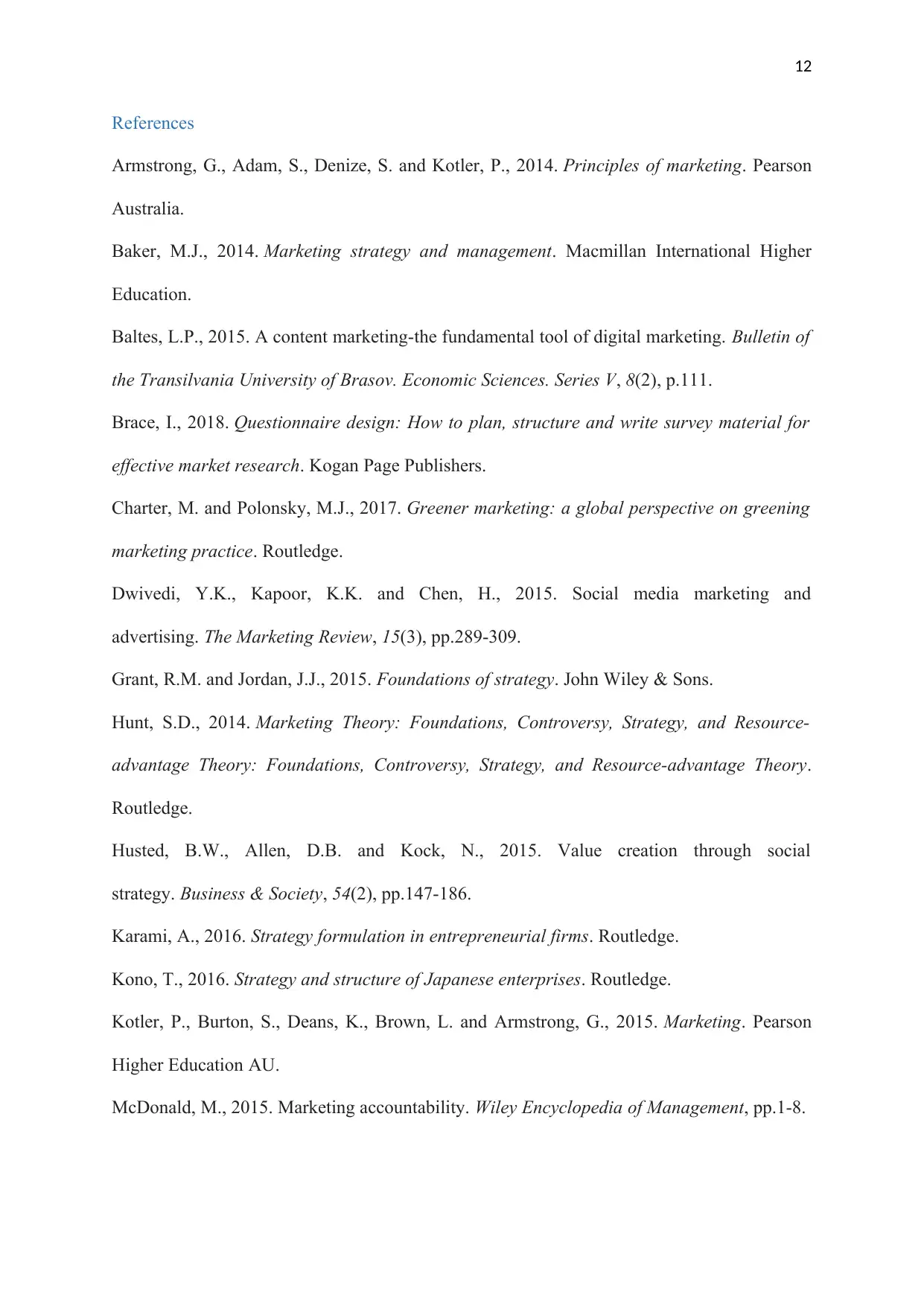
12
References
Armstrong, G., Adam, S., Denize, S. and Kotler, P., 2014. Principles of marketing. Pearson
Australia.
Baker, M.J., 2014. Marketing strategy and management. Macmillan International Higher
Education.
Baltes, L.P., 2015. A content marketing-the fundamental tool of digital marketing. Bulletin of
the Transilvania University of Brasov. Economic Sciences. Series V, 8(2), p.111.
Brace, I., 2018. Questionnaire design: How to plan, structure and write survey material for
effective market research. Kogan Page Publishers.
Charter, M. and Polonsky, M.J., 2017. Greener marketing: a global perspective on greening
marketing practice. Routledge.
Dwivedi, Y.K., Kapoor, K.K. and Chen, H., 2015. Social media marketing and
advertising. The Marketing Review, 15(3), pp.289-309.
Grant, R.M. and Jordan, J.J., 2015. Foundations of strategy. John Wiley & Sons.
Hunt, S.D., 2014. Marketing Theory: Foundations, Controversy, Strategy, and Resource-
advantage Theory: Foundations, Controversy, Strategy, and Resource-advantage Theory.
Routledge.
Husted, B.W., Allen, D.B. and Kock, N., 2015. Value creation through social
strategy. Business & Society, 54(2), pp.147-186.
Karami, A., 2016. Strategy formulation in entrepreneurial firms. Routledge.
Kono, T., 2016. Strategy and structure of Japanese enterprises. Routledge.
Kotler, P., Burton, S., Deans, K., Brown, L. and Armstrong, G., 2015. Marketing. Pearson
Higher Education AU.
McDonald, M., 2015. Marketing accountability. Wiley Encyclopedia of Management, pp.1-8.
References
Armstrong, G., Adam, S., Denize, S. and Kotler, P., 2014. Principles of marketing. Pearson
Australia.
Baker, M.J., 2014. Marketing strategy and management. Macmillan International Higher
Education.
Baltes, L.P., 2015. A content marketing-the fundamental tool of digital marketing. Bulletin of
the Transilvania University of Brasov. Economic Sciences. Series V, 8(2), p.111.
Brace, I., 2018. Questionnaire design: How to plan, structure and write survey material for
effective market research. Kogan Page Publishers.
Charter, M. and Polonsky, M.J., 2017. Greener marketing: a global perspective on greening
marketing practice. Routledge.
Dwivedi, Y.K., Kapoor, K.K. and Chen, H., 2015. Social media marketing and
advertising. The Marketing Review, 15(3), pp.289-309.
Grant, R.M. and Jordan, J.J., 2015. Foundations of strategy. John Wiley & Sons.
Hunt, S.D., 2014. Marketing Theory: Foundations, Controversy, Strategy, and Resource-
advantage Theory: Foundations, Controversy, Strategy, and Resource-advantage Theory.
Routledge.
Husted, B.W., Allen, D.B. and Kock, N., 2015. Value creation through social
strategy. Business & Society, 54(2), pp.147-186.
Karami, A., 2016. Strategy formulation in entrepreneurial firms. Routledge.
Kono, T., 2016. Strategy and structure of Japanese enterprises. Routledge.
Kotler, P., Burton, S., Deans, K., Brown, L. and Armstrong, G., 2015. Marketing. Pearson
Higher Education AU.
McDonald, M., 2015. Marketing accountability. Wiley Encyclopedia of Management, pp.1-8.
⊘ This is a preview!⊘
Do you want full access?
Subscribe today to unlock all pages.

Trusted by 1+ million students worldwide
1 out of 13
Related Documents
Your All-in-One AI-Powered Toolkit for Academic Success.
+13062052269
info@desklib.com
Available 24*7 on WhatsApp / Email
![[object Object]](/_next/static/media/star-bottom.7253800d.svg)
Unlock your academic potential
Copyright © 2020–2025 A2Z Services. All Rights Reserved. Developed and managed by ZUCOL.





